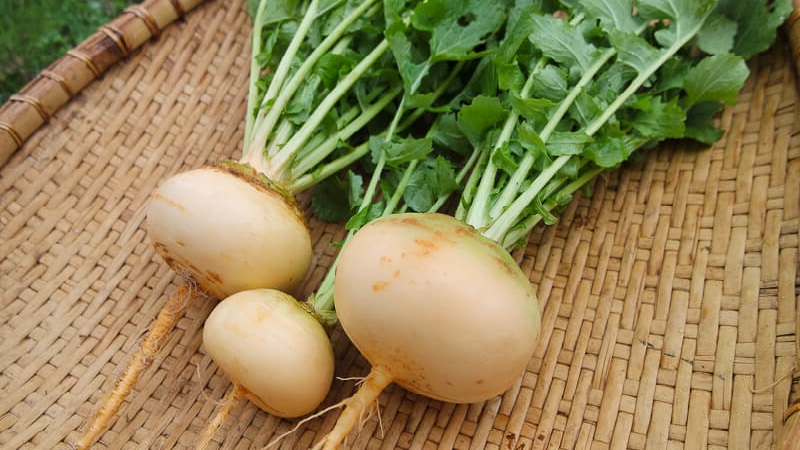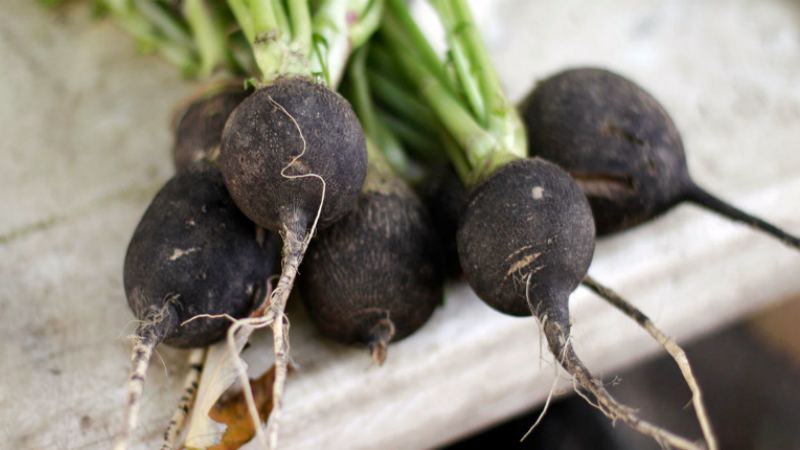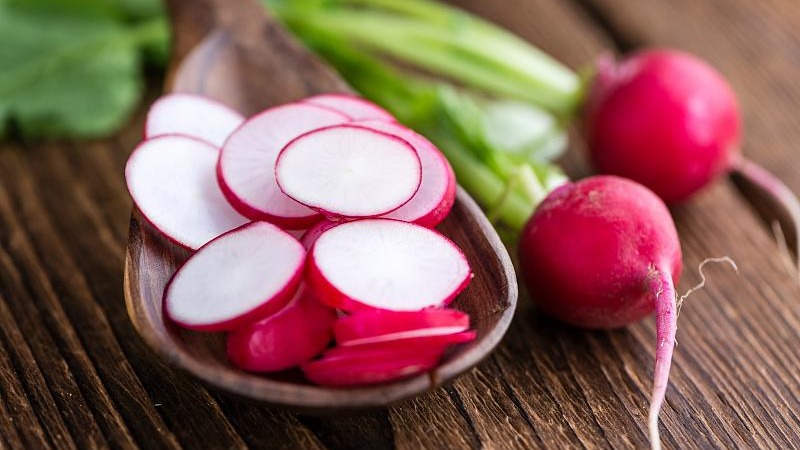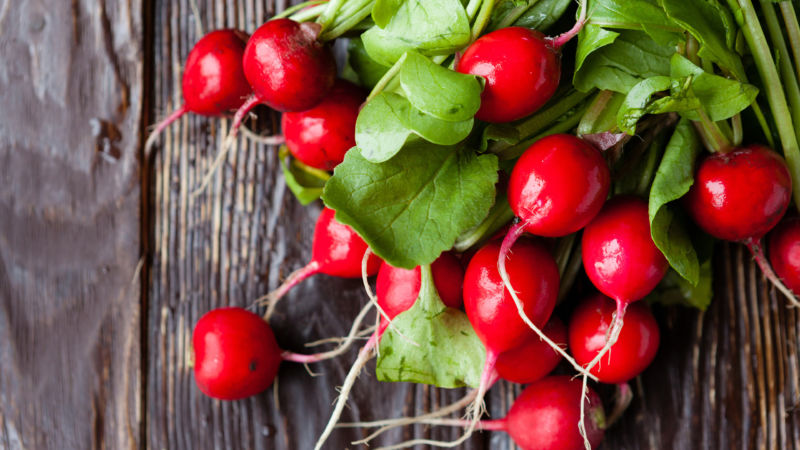The difference between turnips and radishes and radishes
Turnip and radish are healthy vegetables high in vitamins and minerals. Not everyone knows what the difference is between them: the root crops are similar to each other, it is easy to confuse them in color. Understanding the difference between these cultures.
The content of the article
Turnip and radish are relatives, but not the same thing
These plants are close relatives. They belong to the same family (Cruciferous, or Cabbage), but to different genera.
The radish forms a separate genus with the same name, turnip - a species of the genus Cabbage.
Turnip
When we hear the word "turnip", imagine a yellow flattened root vegetable with green leaves on the top and a long tail below. However, breeders are constantly developing new varieties that differ in shape and color. This diversity leads to the fact that turnips are confused with other related root vegetables.
Interesting! The French prefer to use the white turnip in cooking, which has a pink-lilac top, and the fashionable baby-turnip - a smaller version of the white turnip.
There is a forage crop called turnips. This root vegetable has recently been unjustly neglected, although it makes a delicious variety of dishes.
There is no difference between turnip and turnip: these are the names of the same vegetable.

Radish
Radish varieties are very diverse, which affects the appearance of root crops. The vegetable is summer and winter. The first varieties are consumed immediately, the second are stored until spring, without losing their properties.
A subspecies of sowing radish - daikon. It does not contain mustard oils, so the taste is softer without bitterness. Roots are completely white or white on the outside and pink on the inside. The shape is oblong or round.
Summer radish varieties include plants with green and pink-red roots. Green ones have a round or oblong shape, red ones - elongated, resembling large radishes or carrots.
The more common black radish is winter. It is most beneficial for its nutritional and medicinal properties. It has a rounded shape and a white flesh.

Radish
Radish - a kind of sowing radish. The variety of crop varieties is great:
- there are super early and late;
- size varies from miniature to giant;
- the color is white, pink, red, yellow, bi-colored and even purple;
- the shape ranges from round to fusiform.

What is the difference
Despite the family ties, there are a number of differences between turnips, radishes and radishes. By the shape of the root:
- radish is round (black, green, some daikons), oblong (daikons, green), pointed, spindle-shaped or pivotal (daikons, red);
- the turnip is round or flattened, the latter has a depressed tip;
- radish of any shape.
Skin and pulp color:
- radish is white, green, red, black on the outside, the pulp is white, in some varieties - green, in some daikons - pink;
- turnip has a pale yellow, yellow or white skin, the color of the flesh is the same;
- radish is of different colors on the outside, white inside, sometimes with pink veins.
Size and weight:
- Some varieties of turnips grow up to 2 kg (excluding records of 10-15 kg), the weight of a radish rarely exceeds 200-300 g (except for daikon).
- Radish is the smallest of its relatives. Its size rarely exceeds 5 cm in diameter, but sometimes reaches 15 cm in length. The average weight of a vegetable is 10-30 g; there are specimens of 100-150 g each.
Of these plants, radish is distinguished by early maturity, yields in early spring, and is suitable for growing in greenhouses.
What's more useful

All vegetables are suitable for replenishing certain substances.Both turnips and radishes are low in calories: the first contains 32 kcal per 100 g, the second - 36 kcal. The calorie content of radish is even lower - 20 kcal per 100 g. Vegetables are rich in fiber and contain light carbohydrates.
Reference! These root crops contain a lot of vitamin C (most of all in black radish - 32% of the daily value in 100 g of the product), partially lost during heat treatment.
Phytosterols in the composition of root crops cleanse blood vessels from cholesterol deposits. The glucoraphanin in turnips has antibacterial and anti-cancer properties.
Turnip
The vegetable contains:
- vitamins B1, B2, B4, B5, B6, B9, C, E, PP, beta-carotene;
- macro elements: potassium, calcium, silicon, sodium, magnesium, sulfur, phosphorus, chlorine;
- trace elements: boron, vanadium, iron, cobalt, manganese, copper, molybdenum, rubidium, selenium, chromium, zinc.
100 g of root crops account for 303% of the daily value of silicon, 100% vanadium and 70% boron.
Turnip regulates the activity of the gastrointestinal tract, improves the formation of bile, provides muscle nutrition (including the heart), and improves the condition of bones. The vegetable stabilizes sleep and strengthens the nervous system, is good for vision, has antibacterial and antiseptic properties.
Radish

The composition of the sowing, or black, radish:
- vitamins B1, B2, B5, B6, B9, C, E, PP, K, beta-carotene, lutein and zeaxanthin;
- macroelements: potassium, calcium, silicon, magnesium, sulfur, phosphorus, chlorine;
- trace elements: boron, vanadium, iron, cobalt, lithium, manganese, copper, molybdenum, rubidium, chromium, zinc.
100 g of radish contains up to 130% silicon and rubidium, 118% vanadium, 40% boron, up to 20-30% calcium, sulfur and potassium.
Mustard oils, phytoncides and rafanin are responsible for the antiseptic and bactericidal properties of the root crop. Bitter glycosides and essential oils stimulate the secretion of the stomach and gallbladder, lysozyme has an antibacterial effect.
Radish helps with sluggish digestion, but is not recommended for gastritis with high acidity and ulcers. It has an antispasmodic effect on the gallbladder, increases appetite, destroys bad intestinal microflora, stimulates peristalsis, has a mild laxative and diuretic effect.
Reference! The active ingredients of rare juice when applied externally are effective against rheumatism, radiculitis, and joint pain.
Radish is known for its tonic, fortifying and strengthening the immune system. It has a positive effect on the elasticity of blood vessels, removes atherosclerotic deposits.
Radish juice is a powerful expectorant and disinfectant used for any pathology of the respiratory tract, accompanied by cough and runny nose.
Radish

The chemical composition of the radish is close to the radish. Contains less potassium, calcium, sulfur, chlorine and more boron, vanadium, iodine and chromium.
The vegetable improves digestion, increases appetite, speeds up metabolism, promotes the outflow of bile, strengthens the immune system. It has antiseptic and antioxidant properties.
It is interesting:
Fresh radishes all winter: how to keep at home
What is special about white radish: description and characteristics of varieties
What family does the radish belong to, its characteristics and description
Conclusion
Radish, radish and turnip differ in botanical classification, taste, method of application and therapeutic effect. The first two are more often recommended as a vitamin supplement to the main diet or a powerful drug. Exclude them from the diet with increased acidity of the stomach, ulcers and after a heart attack. Turnip provides a healthy metabolism, but is contraindicated for gastritis, ulcers, pancreatitis.